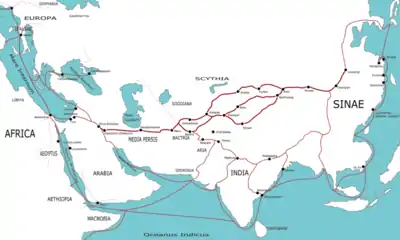印度尼西亚宗教
印度尼西亞在憲法上是一個世俗國家,在建國五項原則的第一項就是信仰神明(Ketuhanan yang Maha Esa)(必須有宗教信仰)。印尼存在了許多不同的宗教,對國家的政治、經濟和文化生活有顯著影響力。[2]印尼憲法保障宗教自由,[3]但政府只认可六種官方宗教(伊斯蘭教、基督新教、天主教、印度教、佛教和孔教)。[4][5][6] 印尼法律規定,每個印尼公民持有的身份宗教欄位上必須要有這六個宗教其中之一,然而這個部分也允許留空。[7] 印度尼西亞不承認不可知論或無神論,褻瀆是不合法的。[8]在2010年的印度尼西亞人口普查中,有87.18%的印度尼西亞人表示自己是穆斯林(和超過99%的遜尼派、[9] 什葉派 0.5%、[10]阿赫邁底亞 0.2%[11]),6.96%基督新教,2.91%天主教,1.69%印度教,0.72%佛教,0.05%孔教,其它宗教0.13%和0.38%未表態。[12]
歷史

歷史上,來自印度,阿拉伯,中國,葡萄牙和荷蘭的移民對印尼的宗教文化多樣性的貢獻了不少。[13]在的亞伯拉罕諸教(伊斯蘭教、基督宗教和猶太教)傳入之前,該地區流行的信仰體系深受印度教和佛教的影響。當印度商人到達蘇門答臘島,爪哇島和蘇拉威西島時,印度教和佛教分別在第二和第四世紀傳入印尼。印度教中的濕婆派在公元五世紀開始在爪哇發展。世界上最大的佛塔遺跡婆羅浮屠便是由信奉金剛乘佛教的爪哇古王國夏連特拉王國建造的,同時期的宗教遺跡還有印度教寺院遺跡普蘭巴南。爪哇的印度文化頂峰是十四世紀的滿者伯夷王朝,被形容為印尼歷史上的黃金時代。[14]
伊斯蘭教在公元十四世紀被引入印度尼西亞。[13] 來自印度古吉拉特邦的穆斯林商人,將伊斯蘭教從蘇門答臘西海岸傳入印尼,然後經由爪哇島發展到印尼東部。
葡萄牙將天主教信仰引進印尼,特別是在弗洛勒斯島和帝汶島[15];基督新教由荷蘭在十六世紀引進,主要為加爾文宗和路德宗。[16]
國家認可的宗教
伊斯蘭教

遜尼派
印度尼西亞伊斯蘭教的歷史非常複雜,反映了印尼文化的多樣性。[17] 早在公元8世紀就有阿拉伯穆斯林商人進入印度尼西亞的證據。[18] 到15世紀,在蘇門答臘和爪哇的傳教士馬利克·易卜拉欣(Malik Ibrahim)和鄭和加速了伊斯蘭教的傳播。與中東伊斯蘭教相比,印度尼西亞的伊斯蘭教在很多情況下都沒有經過精心的實踐。[19]大多數印度尼西亞穆斯林屬於遜尼派中的沙斐儀派。[9]
阿赫邁底亞
印尼約有40萬阿赫邁底亞穆斯林,遍布全國各地542個分支機構。如同印尼的什葉派,阿赫邁底亞穆斯林常被主流的遜尼派穆斯林歧視,面臨越來越多的不容忍。
新教

基督教新教信仰在很大程度上是荷蘭改革宗和路德宗在印尼的殖民時期傳教的結果。[20][21][22] 荷蘭東印度公司管理在印尼的傳教工作,並將傳教活動限制在印尼群島的東部。[23] 雖然改革宗和路德宗這兩個分支是印尼最常見的新教教派,許多其他新教教派也在印尼存在。[24] 巴塔克基督新教教會是印尼最大的路德宗教會。[25]
根據統計,2010年新教基督徒佔印尼總人口的7%;印尼民族當中,托拉查人中有65%是新教徒,巴塔克人也是新教信仰的族群之一。印度尼西亞華人也是新教族群,華裔基督徒分佈在整個印度尼西亞,大部分集中在主要城市地區。在2000年,印尼大約有35%的華人是新教基督徒。印度尼西亞目前有3個新教基督徒佔多數省份:西巴布亞省、巴布亞省和北蘇拉威西省;分別佔總人口的60%,68%和64%。[26]
羅馬天主教

天主教在葡萄牙到達印度尼西亞做香料生意期間傳入印尼。[27]截至2006年,印度尼西亞人口中有3%是天主教基督徒,天主教信徒主要居住在西加里曼丹省,巴布亞省和東努沙登加拉省。東努沙登加拉省的弗洛勒斯島和西帝汶為印尼天主教信徒佔多數的地方,約佔印尼總人口的54.56%。
印度教

印度尼西亞的印度教信仰與世界其他地區的印度教信仰截然不同,[28] 印尼印度教信仰被稱為巴厘印度教(印尼語:Agama Hindu Bali)。印尼印度教信仰從未使用過種姓制度,並納入了崇敬自然的光明,神靈和亡靈的南島元素。印度宗教史詩 “ 摩訶婆羅多”和“ 羅摩衍那”以獨特的印度尼西亞風格的木偶皮影戲和舞蹈表現出來。在爪哇的許多地區,印度教和伊斯蘭教相互影響很大。[29]
截至2007年,印尼印度教徒的官方數字是一千萬。[30] 印度尼西亞是世界上第四大印度教國家,93%的印度教徒分佈在於巴里島。除了巴厘島外,蘇門答臘島,爪哇島,龍目島,加里曼丹島和蘇拉威西島也有一定數量的印度教徒分佈 。在印尼,錫克教徒通常註冊歸類為印度教徒,因為印度尼西亞政府不承認錫克教是一種宗教。
其他宗教信仰
人口統計
| 1971[37][38] | 1980[39][40] | 1985[41] | 1990[41][42][43] | 2000[41][44][45] | 2005[41] | 2010[1] | ||||||||
|---|---|---|---|---|---|---|---|---|---|---|---|---|---|---|
| 穆斯林 | 103.58 | 87.51% | 128.46 | 87.94% | 142.59 | 86.92% | 156.32 | 87.21% | 177.53 | 88.22% | 189.01 | 88.58% | 207,18 | 87.18% |
| 基督新教 | 8.74 | 7.39% | 8.51 | 5.82% | 10.59 | 6.46% | 10.82 | 6.04% | 11.82 | 5.87% | 12.36 | 5.79% | 16.53 | 6.96% |
| 天主教 | 4.36 | 2.98% | 5.14 | 3.13% | 6.41 | 3.58% | 6.13 | 3.05% | 6.56 | 3.07% | 6.91 | 2.91% | ||
| 印度教 | 2.30 | 1.94% | 4.76 | 3.26% | 3.18 | 1.94% | 3.29 | 1.83% | 3.65 | 1.81% | 3.70 | 1.73% | 4.01 | 1.69% |
| 佛教 | 1.09 | 0.92% | 1.60 | 0.98% | 1.84 | 1.03% | 1.69 | 0.84% | 1.30 | 0.61% | 1.70 | 0.72% | ||
| 儒教(孔教)[46] | 0.97 | 0.82% | 0.95 | 0.58% | 0.57 | 0.32% | 0.41 | 0.20% | 0.21 | 0.10% | 0.12 | 0.05% | ||
| 其他宗教 | 1.69 | 1.42% | 0.24 | 0.11% | 0.30 | 0.13% | ||||||||
| 未表態 | 0.14 | 0.06% | ||||||||||||
| 沒訪問 | 0.76 | 0.32% | ||||||||||||
| 總計數目[47] | 118.37 | 146.08 | 164.05 | 179.25 | 201.24 | 213.38 | 237.64 | |||||||
參考文獻
- Bertrand J, Nationalism and Ethnic Conflict in Indonesia, Cambridge : Cambridge University Press, 2004, 278 pages, ISBN 0-521-81889-3. Retrieved 22 October 2006
- Hunt, Stephen J. . Aldershot, Hampshire: Ashgate Publishing. 2003. ISBN 0-7546-3410-8.
- International Coalition for Religious Freedom. (2004). "Indonesia". "Religious Freedom World Report". Retrieved 6 September 2006
- Llyod G and Smith S, Indonesia Today, Lanham, Maryland : Rowman & Littlefield Publishers, 2001, 343 pages, ISBN 0-7425-1761-6
- Shaw, E. "Indonesian Religions". "Overview of World Religions". Retrieved 8 September 2006
- Bunge, F.M. (ed.). . US Library of Congress. 1983 [2 October 2006].
- Popov, I. Buku rujukan semua aliran dan perkumpulan agama di Indonesia [The Reference Book on All Religious Branches and Communities in Indonesia], Singaraja : Toko Buku Indra Jaya, 2017, 113 pages. Retrieved
参考註釋
- [Population by Region and Religion]. Sensus Penduduk 2010. Jakarta, Indonesia: Badan Pusat Statistik. 15 May 2010 [20 November 2011]. (原始内容存档于2018-12-24).
Religion is belief in Almighty God that must be possessed by every human being. Religion can be divided into Muslim, Christian, Catholic, Hindu, Buddhist, Hu Khong Chu, and Other Religion.
Muslim 207176162 (87.18%), Christian 16528513 (6.96), Catholic 6907873 (2.91), Hindu 4012116 (1.69), Buddhist 1703254 (0.72), Confucianism 117091 (0.05), Other 299617 (0.13), Not Stated 139582 (0.06), Not Asked 757118 (0.32), Total 237641326 - . Swipa. [2 October 2006]. (原始内容存档于2017-10-29).
- . [2 October 2006]. (原始内容存档于2007-03-10).
- Yang, Heriyanto. (PDF). Marburg Journal of Religion. 2005, 10 (1) [2 October 2006]. (原始内容存档 (PDF)于2006-09-10).
- Hosen, N. (PDF). Journal of Southeast Asian Studies (Cambridge University Press). 8 September 2005, 36 (3): 419 [26 October 2006]. doi:10.1017/S0022463405000238. (原始内容 (PDF)存档于2006年8月28日).
- Sugana, Marsha. . Jakarta Post. 6 October 2011 [20 January 2012]. (原始内容存档于2012年1月30日).
- , , United States Department of State, 26 October 2009 [28 January 2013],
The 2006 civil registration bill requires citizens to identify their religion on National Identity Cards (KTP). The bill does not allow citizens to identify themselves as anything outside of the six recognized religious groups. Legally, citizens may leave the religious section blank, but some local government officials are not familiar with this option. Members of unrecognized religious groups are often unable to obtain KTPs as a result.
- (PDF). [25 May 2017].
- . [2018-01-19]. (原始内容存档于2017-05-06).
- There are approximately 1 million Shia Muslims in the country which approximates to 0.5% of the total Muslim population. See:
Reza, Imam. . [11 June 2009]. (原始内容存档于2009年5月22日).
approximately 400,000 persons who subscribe to the Ahmadiyya
- There are approximately 400,000 Ahmadi Muslims in the country, which equates to 0.2% of the total Muslim population. See: . US Department of State. [31 March 2014]. (原始内容存档于2014-04-14).
- [Population by Region and Religion]. Sensus Penduduk 2010. Jakarta, Indonesia: Badan Pusat Statistik. 15 May 2010 [20 November 2011]. (原始内容存档于2018-12-24).
Religion is belief in Almighty God that must be possessed by every human being. Religion can be divided into Muslim, Christian, Catholic, Hindu, Buddhist, Hu Khong Chu, and Other Religion.
Muslim 207176162 (87.18%), Christian 16528513 (6.96), Catholic 6907873 (2.91), Hindu 4012116 (1.69), Buddhist 1703254 (0.72), Confucianism 117091 (0.05), Other 299617 (0.13), Not Stated 139582 (0.06), Not Asked 757118 (0.32), Total 237641326 - . Encyclopedia of Philosophy, Theology and Religion (PHILTAR). St. Martin's College. [2 October 2006]. (原始内容存档于2006年10月6日).
- Pariwono, John I.; Abdul Gani Ilahude; Malikusworo Hutomo. (PDF). Oceanography (The Oceanography Society). December 2005, 18 (4): 8 [27 October 2006]. doi:10.5670/oceanog.2005.04. (原始内容 (PDF)存档于2007年1月5日).
- (PDF). OMF International. September 2003 [27 October 2006]. (原始内容 (PDF)存档于2007年9月29日).
- Encyclopedia of Protestantism: 4-volume Set by Hans J. Hillerbrand, chapter on Indonesia, p. 824
- cf. Bunge (1983), chapter Islam 页面存档备份,存于.
- Martin, Richard C. . Macmillan. 2004.
- . Centre Universitaire d'Informatique. [20 October 2006]. (原始内容存档于2006-09-14).
- Ricklefs 1991, pp. 28, 62.
- Vickers 2005, p. 22.
- Goh, Robbie B.H. . Institute of Southeast Asian Studies. 2005: 80. ISBN 981-230-297-2.
- Encyclopedia of Protestantism: 4-volume Set by Hans J. Hillerbrand, chapter on Indonesia, p. 824
- . Reformed Online. Reformed Online. [7 October 2006]. (原始内容存档于2006-12-05).
- Encyclopedia of Protestantism: 4-volume Set by Hans J. Hillerbrand, chapter on Indonesia, p. 337
- . Ministry of Religion of Indonesia. Board for Statistics Center 2005. 2005 [2 October 2006]. (原始内容 (Indonesian)存档于2007-12-14).
- . U.S. Library of Congress. U.S. Library of Congress. [7 October 2006]. (原始内容存档于2011-08-05).
- cf. Bunge (1983), chapter Hinduism 页面存档备份,存于.
- Lidde, R. William. . Journal of Asian Studies (Association for Asian Studies). 1 August 1996, 55 (3): 613–634. ISSN 0021-9118. JSTOR 2646448. doi:10.2307/2646448.
- Indonesia International Religious Freedom Report 2007 - US State Department
- . Buddha Dharma Education Association. Buddha Dharma Education Association. 2005 [3 October 2006]. (原始内容存档于2002-02-14).
- Flanagan, Anthony. . About. 2006 [3 October 2006]. (原始内容存档于2007年8月19日).
- cf. Bunge (1983), chapter Buddhism 页面存档备份,存于.
- cf. Bunge (1983), chapter Buddhism 页面存档备份,存于.
- . PHILTAR. PHILTAR. [4 October 2006]. (原始内容存档于2006年10月6日).
- Schiller, Anne. Schieman, Scott , 编. (PDF). Sociology of Religion (Oxford University Press). 1996, 57 (4): 409–417 [21 November 2011]. ISSN 1759-8818. OCLC 728290653. doi:10.2307/3711895.
- (PDF) 31. New York: United Nations. 1980. p. 641 Table 29. Population by religion, sex and urban/rural residence: each census, 1970-1979 [21 November 2011]. ISBN 978-0-8002-2882-8. OCLC 16991809. (原始内容存档 (PDF)于2019-01-09).
- C.I.C.R.E.D. cites [National Survey of Social and Economic Fourth Round – Demographic Characteristics of the Population]. Jakarta: Biro Pusat Statistik (Central Bureau of Statistics). 1969. for Table III.10 of "The Population of Indonesia, 1974 World Population Year", p. 31. However, due to inaccessibility of the data source for verification and data collection proximity to census year 1971, referenced 1969 data is not included in this article's table. (PDF). C.I.C.R.E.D. 2. Jakarta: Lembaga Demografi (Demographic Institute), Universitas Indonesia. 30 September 1973: 31–32 [15 December 2011]. LCCN 77366078. OCLC 3362457. OL 4602999M. (原始内容存档 (PDF)于2016-10-21).
The statistical data on religion show that Islam has the highest percentage of adherents with about 87.1 per cent of the population of Indonesia (National Socio Economic Survey, 1969). The second biggest religion in Indonesia is Protestant (5.2%), while Catholic is the third (2.5%). The rest are Hindu (2.0%) and Buddhist (1.1%) and other religions which are not included in the above classification.
- Aritonang, Jan S.; Steenbrink, Karel A. . Studies in Christian mission 35. Leiden, The Netherlands: Koninklijke Brill NV. 2008: 216 [20 November 2011]. ISBN 978-90-04-17026-1. OCLC 228370027.
- Unable to find online data for Sensus Penduduk 1980 (Penduduk Indonesia: hasil sensus penduduk. Jakarta: Badan Pusat Statistik, 1980). Unable to find online version of [Statistical Pocketbook Of Indonesia 1982]. Jakarta, Indonesia: Biro Pusat Statistik. 1983. OCLC 72673205., which contains 1980 census data.
- Cholil, Suhadi; Bagir, Zainal Abidin; Rahayu, Mustaghfiroh; Asyhari, Budi. (PDF). Max M. Richter, Ivana Prazic. Yogyakarta, Indonesia: Center for Religious & Cross-cultural Studies, Gadjah Mada University: 15. Aug 2010 [20 November 2011]. ISBN 978-602-96257-1-4. (原始内容 (PDF)存档于2012-04-25).. Cites BPS-Statistics Indonesia for intercensal population survey 1985, census 1990, census 2000, and intercensal population survey 2005
- Ricklefs, Merle Calvin. 3. Stanford, CA: Stanford University Press. 2001: 379 [21 November 2011]. ISBN 978-0-8047-4480-5.
The 1990 census recorded 156.3 million Muslims in Indonesia, 87.2 per cent of the population and the largest Muslim population of any nation in the world. This was a steady percentage, having been 87.1 per cent in 1980. Christians (Catholics and Protestants) totalled 17.2 million, 9.6 per cent of the population, whereas in 1971 the figure was 7.5 per cent and in 1980 it was 8.8 per cent. So Christianity was still growing. In the large cities of Central Java in particular, Christians constituted nearly 20 per cent of the population. The rising tide of religiosity was also reflected in the much smaller communities of Hindus (3.3 million, 1.8 per cent of the population in 1990) and Buddhists (1.8 million, 1.0 per cent of the population).
- The 1990 census recorded 87.21% Muslims, 6.04% Protestants, 3.58% Catholics, 1.83% Hindus, 1.03% Buddhists and 0.31% as "Others". Population of Indonesia: Results of the 1990 Population (Jakarta: Biro Pusat Statistik, 1992), p. 24, as cited by Intan, Benyamin Fleming. . American University Studies: Theology and Religion 238. New York, NY: Peter Lang. 2006: 6 [15 December 2011]. ISBN 978-0-8204-7603-2.
- (XLS). Demographic Yearbook (Spreadsheet) (New York: United Nations). 30 June 2006,. 2b - Ethnocultural characteristics [5 November 2011]. ISSN 0082-8041. OCLC 173373970. (原始内容存档于2018-11-02).
|contribution-url=被忽略 (帮助) - . The World Factbook. Washington, D.C.: U.S. Central Intelligence Agency. People and Society. 18 October 2011 [8 November 2011]. ISSN 1553-8133. (原始内容存档于2018-12-24).
Muslim 86.1%, Protestant 5.7%, Roman Catholic 3%, Hindu 1.8%, other or unspecified 3.4% (2000 census)
- In 1979, Soeharto retracted official recognition of Confucianism. Hence Confucianism appears in the 1971 census data, but not in 1980 or 1990. In 2000, Indonesia decided to separately categorize Confucianism only during the enumeration process, but did not actually list this option on the printed form. This is not listed as a separate category in the U.N. data. Utomo, Ariane J. (PDF). Prof. Terence H. Hull. The Australian National University: 7. March 2003 [20 November 2011]. (原始内容 (PDF)存档于2012年4月25日).
The six categories for religion were Islam, Catholicism, Protestant, Hinduism, Buddhism, and Other. The decision to have a separate category for Confucianism (Kong Hu Cu) occurred during the enumeration process itself, hence it was not printed in the actual form of the L1. The data on the number of Confucians is only available for certain provinces. However, the number seems much smaller than expected due to the abrupt process of including it in the questionnaire.
- Totals and lefthand column per year are in millions of persons.

